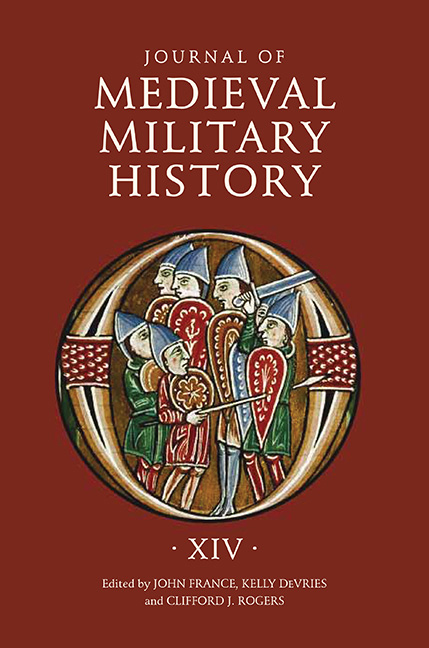Book contents
- Frontmatter
- Contents
- 1 Anglo-Norman Artillery in Narrative Histories, from the Reign of William I to the Minority of Henry III
- 2 Imperial Policy and Military Practice in the Plantagenet Dominions, c. 1337–c. 1453
- 3 The Parliament of the Crown of Aragon as Military Financier in the War of the Two Pedros
- 4 Chasing the Chimera in Spain: Edmund of Langley in Iberia, 1381/82
- 5 Note: A Medieval City under Threat Turns Its Coat, while Hedging Its Bets – Burgos Faces an Invasion in Spring 1366: Introduction and Translation
- 6 Medieval European Mercenaries in North Africa: The Value of Difference
- 7 Medieval Irregular Warfare, c. 1000–1300
- 8 Muslim Responses to Western Intervention: A Comparative Study of the Crusades and Post-2003 Iraq
- 9 “New Wars” and Medieval Warfare: Some Terminological Considerations
- 10 Friend or Foe? The Catalan Company as Proxy Actors in the Aegean and Asia Minor Vacuum
- List of Contributors
- Journal of Medieval Military History
- De Re Militari and the Journal of Medieval Military History
1 - Anglo-Norman Artillery in Narrative Histories, from the Reign of William I to the Minority of Henry III
Published online by Cambridge University Press: 12 September 2017
- Frontmatter
- Contents
- 1 Anglo-Norman Artillery in Narrative Histories, from the Reign of William I to the Minority of Henry III
- 2 Imperial Policy and Military Practice in the Plantagenet Dominions, c. 1337–c. 1453
- 3 The Parliament of the Crown of Aragon as Military Financier in the War of the Two Pedros
- 4 Chasing the Chimera in Spain: Edmund of Langley in Iberia, 1381/82
- 5 Note: A Medieval City under Threat Turns Its Coat, while Hedging Its Bets – Burgos Faces an Invasion in Spring 1366: Introduction and Translation
- 6 Medieval European Mercenaries in North Africa: The Value of Difference
- 7 Medieval Irregular Warfare, c. 1000–1300
- 8 Muslim Responses to Western Intervention: A Comparative Study of the Crusades and Post-2003 Iraq
- 9 “New Wars” and Medieval Warfare: Some Terminological Considerations
- 10 Friend or Foe? The Catalan Company as Proxy Actors in the Aegean and Asia Minor Vacuum
- List of Contributors
- Journal of Medieval Military History
- De Re Militari and the Journal of Medieval Military History
Summary
Between the Norman conquest of England and the minority of Henry III there is a significant transition in the way that artillery is dealt with by narrative sources. References to these engines are initially quite vague but become more specific from the second half of the twelfth century. The most detailed descriptions of artillery, however, are found in accounts of the crusades, often composed by eyewitnesses or figures closer to events than their European contemporaries. This study aims to reveal how artillery was employed by and against Anglo-Norman forces between 1066 and 1226, before it became a fixture in English administrative records. The development of these engines will be traced by analysing contemporary descriptions and the terminology used by various sources on a case-by-case basis. The vivid descriptions of the engines employed by Anglo-Norman crusaders will be used as markers of development, allowing evidence from Europe to be evaluated in between these contextual waypoints. It becomes clear quite quickly how broadly this technology was appreciated, how the constant interactions of various armies ensured that knowledge was continually circulating, and how the perceived value of artillery increased with time.
To begin, “artillery” will be used to refer to stone-throwing mechanical siege engines. It is widely accepted that swing-beam, or trebuchet, artillery was the predominant form of artillery in Europe during the High Middle Ages. These engines were composed of a main beam rotating around a horizontal off-centre axle and functioned according to the principle of mechanical advantage: force was applied at the end of the short arm of the beam, leading the end of the long arm to move at a greater rate. To increase efficiency, a sling was attached at the end of the long arm, forcing the projectile couched within to travel even farther, and thus faster, before release. Originally, the powering force was provided by teams of men pulling ropes fixed to the short end of the beam. These traction trebuchets were later complemented by heavier counterweight trebuchets, which used the gravitational force acting upon a large mass fixed to the end of the short arm as an alternative power source.
- Type
- Chapter
- Information
- Journal of Medieval Military HistoryVolume XIV, pp. 1 - 32Publisher: Boydell & BrewerPrint publication year: 2016



